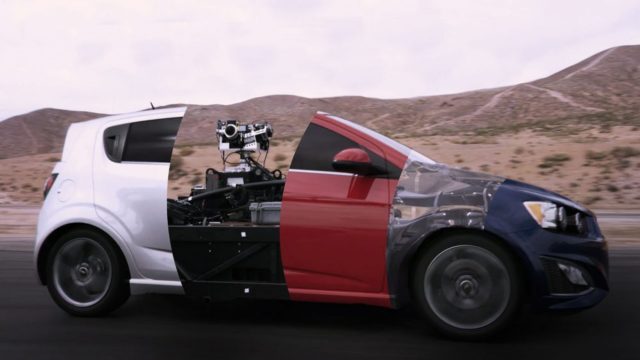Epic Games founder and CEO Tim Sweeney received the GDC Lifetime Achievement Award at the 17th Annual Game Developers Choice Awards in San Francisco this week. Sweeney has built his company into a powerhouse in the video game industry with franchises like Unreal Tournament (which has a new free-to-play game in development), Gears of War (which was sold to Microsoft in 2014) and Infinity Blade (from Chair Entertainment). GDC marks the debut of the company’s newest game, Battle Breakers.
But thanks to Unreal Engine 4, Epic has expanded its reach across many verticals, including Hollywood, the automobile industry and architecture through its internal Unreal Engine Enterprise division.
At GDC Epic is showcasing a new project with ad agency The Mill and Chevrolet that uses UE4 technology to augment reality for shooting car commercials. Unreal is also giving Chevy a new platform for customers to customize their vehicles in showrooms of the future.
Sweeney talks about the evolving business opportunities for UE4, as well as the growing virtual reality and augmented reality industries in this exclusive interview.
What opportunities does augmented reality open up for your game engine technology?
Augmented reality includes any combination of computer imagery with real-world objects in any form. Pokémon GO is augmented reality. There are different classes like HoloLens and Magic Leap. But there’s also a lot in between. It’s a huge factor in Hollywood cinematography to mix CG objects in with the real environment and the engine has to solve all these problems. Every aspect of the real-world scene has to be matched by the computer objects you see on top of them. The lighting, the motion blur, the overall appearance of the environment. There’s a lot to get right.
And one of the things we believe pretty strongly about and will be a big part of everybody’s future is how do you actually make things look real? How do you integrate with real light and real photography?
We’re going to be ahead of the game of solving these problems as the devices get more and more sophisticated. With augmented reality, at some point people will absolutely demand realism, so we just want to make sure that the engine’s ready to scale to that level. So it’s nice to do these very high-end AR projects with real cameras, as opposed to simple cell phone cameras.
It’s probably a $100,000 Arraiy camera that’s shooting that photography, and if we can scale all that way with high-end range photography with all the bells and whistles that the movie business demands, we know that we’re going to scale it down to much simpler use cases.
What does UE4 open up for the auto industry?
For more traditional businesses like GM, they have car configurators. Almost everybody nowadays, if you’re going to custom order a car, and not just get it off the dealer lot, you’re going to spend some time in a car configurator, choose your options and get some sort of simple visualization of it. This allows you to actually not only see an incredibly real version car that you want to have built for you, but it also allows you to see the car in a fantasy environment. You can go deeper with the car that you configured by seeing it race, or maybe driving it in a video game environment.
Did you have any idea when you first launched this game company that video game technology would be used across so many verticals?
No, it’s amazing we’ve gotten to this point. We’ve had a pretty good track record at Epic of seeing where things were heading, but there were a few things that caught me completely by surprise. I did not even envision that 3D graphics would be a practical reality until id Software shipped Wolfenstein 3D, for example. It seemed like some absurd, high-end feature that required quarter million dollar workstations, but now we’re right in the center of it. It is becoming increasingly straightforward now to see 10 years ahead what this is going to be like. With every smartphone, television, computer and tablet being replaced by augmented reality glasses which let you see a seamless combination of all of this. All of these computer images with real-world environment will be integrated with really advanced user interfaces on top, so you’re constantly immersed.
And engines are going to have to be at the center of the online reality revolution because everything is going to be 3D. It’s not like any previous platform, which was largely a 2D user interface with a few 3D apps on it.
Generations of kids have grown up customizing games and avatars and everything in their lives. What does this Chevy project foreshadow about the future?
Just think of the impact of this on commerce. Now you can configure thousands of options on a product like a car, but also because you have that configuration capability, the way that companies design customizable products can change. Now, if you can go on to Amazon and customize all the attributes of all these different objects you’re buying, then suddenly it’s going to open up a world of possibilities. It’s all going to be powered by real-time 3D graphics.

There have been billions poured into virtual reality and Epic Games has its Oculus Touch game, Robo Recall at GDC. How do you see the VR market growing moving forward?
VR is where the rubber is meeting the road in all of these applications. You have a highly dedicated audience of gamers buying VR hardware, playing VR games and spending money on VR products, which enables everybody to reinvest in building more.
It started very small. Unlike all of these previous revelations of smartphones and new console platforms, all VR apps have to be designed from the ground up for VR. So we’re really starting from zero. We will continue to see exponential growth on top of the base of hardcore VR hardware that’s out there today, so maybe next year there will be three or four or five million VR units out, and then the year after that maybe 10 million. The year after that maybe 20 million. At some point you’re talking about a VR install base across all these different platforms that is comparable to the console audience.
At each step, you’re going to see the economics for development teams improve, which will enable them to build bigger and better games. Right now it’s small. It’s experimental. We’re seeing teams of 25 people working on Robo Recall. That’s the state of it now. It’s going to be every bit as big as console gaming was in previous decades.
It seems like some investors in VR are getting antsy and they were expecting smartphone or tablet sales figures.
Judging by smartphone standards there aren’t a billion VR units out there, so it’s completely failed, right?
Remember the first generation of iPhone games when everybody portered their shooters to mobile and found the controls weren’t very good? There’s been some of that in VR, too. But now we’re seeing the emergence of integrity in these types of games that don’t even belong to existing genres. That’s where the innovation will really occur. Nobody’s first app in VR is going to be a killer app. It’s going to be the second and third tries for all these developers. So we need to give the market time to develop and be patient.

